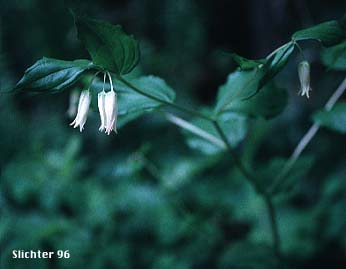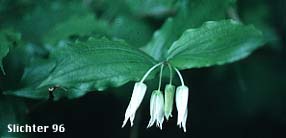 Characteristics:
Characteristics:
Fairy lanterns are a very attractive perennial wildflower with erect to ascending, freely branched stems rising from 20-90 cm high. The herbage of the stout stems ranges from lacking hairs entirely to being sparsely soft-puberulent. The leaves are found entirely on the stems and are broadly lanceolate or ovate in shape, tapering gradually to a pointed tip. The leaf base is rounded or subcordate. The leaves measure from 6-12 cm long, have parallel venation and wavy leaf margins.
The inflorescence consists of 2-5 pendant flowers in clusters at the tips of the branches. The 6 white tepals are oblong-lanceolate in shape and not as narrowed at the base as those of fairy lanterns. The tepals measure from 15-28 mm long and the tips of the individual tepals flare outwards only slightly (See photos.). The stamens are much shorter than the tepals. The fruit is a smooth yellow to orange berry which is oblong-obovoid in shape. It measures from 12-15 mm in length and is edible although probably not highly desirable for human consumption.
Fairy lanterns are similar in appearance to fairy bells, but the tips of the tepals of the latter plant flare outwards to give a bell shape.
Fairy lanterns are excellent plants for use in the shade garden. They are best used at mid-depth in a shaded flower bed or as a medium height plant lining a path through the woods. They will also set seed fairly easily to spread, but are not as invasive as many non-native plants.
Fairy lanterns may be found in moist shaded woods. They can tolerate fairly deep shade.
Fairy lanterns are found west of the Cascade crest from British Columbia south to San Mateo County in California.
In the Columbia River Gorge they may be found between the elevations of 100'-2500' from Troutdale, OR east to Dog Mt..
